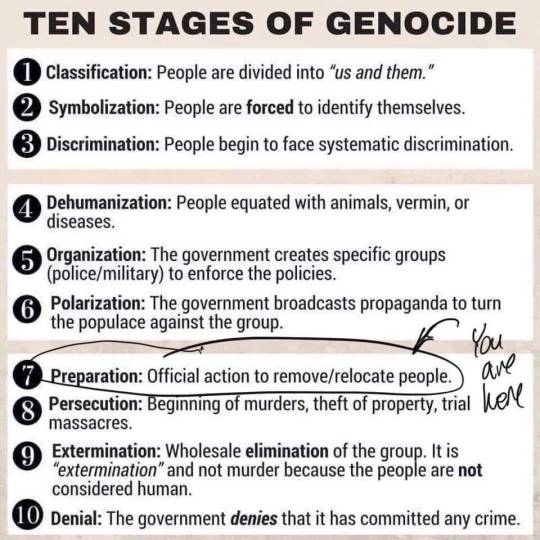Either buried underground or drifted off into space22 they/them
Don't wanna be here? Send us removal request.
Text
Not an attempt to downplay current happenings at All but I am noticing a scary number of people acting like certain political developments in the usa are brand new and shocking and unfathomable as though that government did not put japanese people in concentration camps and do the chinese exclusion act and lynch mexicans in an institutionalised form with the texas rangers and let the KKK exist and well the entire relationship between the average settler and indigenous people for the past like 400 years and so on and so forth
9K notes
·
View notes
Text
now that ICE is going to be the most rapidly expanding large hiring force in the united states how many people do you think are going to justify working for them and complain about how nobody respects them
#you can already see it in the way people have been#justifying joining the military and its what theyve been doing for years
13K notes
·
View notes
Text
the reason you, a white american, believe that white americans don't have culture is the same reason fish don't believe in water
35K notes
·
View notes
Text
Some people on this website are so anti-conspiracy-minded, they veer into “nothing ever happens” territory. The CIA overthrew dozens of democraticly elected governments from the 50s through the 90s, and then they stopped, quietly, out of the goodness of their hearts.
1K notes
·
View notes
Text
The Kuriakoses’ experience was an early taste of a phenomenon that, over the next few decades, spread across most of India’s big cities. As a more standardized international approach to building design emerged, many Indian architects abandoned the vernacular traditions that had been developed over thousands of years to cope with the weather extremes of different regions. The earthen walls and shady verandas of the humid south, and the thick insulating walls and intricate window shades of the hot dry northwest, were swapped for a boxy modern style. Today, buildings in downtown Bangalore often look like those in Ahmedabad, in the north, or Chennai, in the east—or those in Cincinnati, Ohio, or Manchester, England.
In the climate change era, that uniformity is looking like a mistake. Large parts of India have been stifled by a spring heatwave since April, with temperatures lingering close to 110°F for weeks in some places, and topping 120°F in Delhi this week, making it dangerous to go to work or school—all weeks before the official start of summer. Spiking energy demand for cooling has helped trigger daily blackouts in cities, and what AC units are running are belching hot air into streets, worsening the urban heat island effect. As such heatwaves become increasingly common and long-lasting, experts say India’s modern building stock will make it harder for Indians to adapt.
The architecture of Indian cities began to change rapidly in the 1990s, when the country transitioned to a market-based economy. As construction boomed, Western or globalized styles became the norm. The shift was partly aesthetic; developers favored the glassy skyscrapers and straight lines deemed prestigious in the U.S. or Europe, and young architects brought home ideas they learned while studying abroad. Economic considerations also played a role. As land became more expensive in cities, there was pressure to expand floorspace by eliminating thick walls and courtyards. And it was faster and easier to throw up tall structures using steel and concrete, rather than use traditional earth blocks which are suited to lower-rise structures.
The consequence of that cookie-cutter approach was to make buildings less resilient to India’s high temperatures. The impact of that once seemed minimal. It could easily be offset by electric fans and air conditioning, and the energy costs of cooling were not developers’ problems once they sold their buildings. “Where a home [built in the vernacular style] needs around 20 to 40 kilowatt hours per meter squared of energy for cooling, today some commercial places need 15 times that,” says Yatin Pandya, an architect based in Ahmedabad. When AC units are turned on to help people sleep at night, they release heat into the streets, which can increase the local temperature by around 2°F according to U.S.-based studies. During the day, depending on their orientation, glassy facades can reflect sunlight onto footpaths. “You’re creating [problems] in every direction.”
The shift away from climate-specific architecture hasn’t only affected offices and luxury flats, whose owners can afford to cool them. To maximize urban space and budgets, a massive government housing program launched in 2015 has relied largely on concrete frames and flat roofs, which absorb more heat throughout the day than sloped roofs. “We’re building hot houses. In certain parts of the year, they will require cooling to be habitable,” says Chandra Bhushan, a Delhi-based environmental policy expert. He estimates that roughly 90% of the buildings under construction today are in a modern style that pays little attention to a region’s climate—locking in increased heat risk for decades to come.
Similar shifts have happened in developing countries all over the world, with cities from the Middle East to Latin America taking on the “copy and paste texture of globalized architecture,” says Sandra Piesik, a Netherlands-based architect and author of Habitat: Vernacular Architecture for a Changing Planet. As the global construction industry embraced concrete and steel, local materials, designs, and technologies became displaced—with lasting consequences. “Some of these traditional methods didn’t undergo the technological revolution that they needed,” to make them more durable and easier to use on a massive urban scale, Piesek says. “We focused instead on [perfecting] the use of concrete and steel.”
5K notes
·
View notes
Text
the central construction of ptsd as an etiology seems to be for murderers
4K notes
·
View notes
Text

Please donate to Eman’s family. They are #12 on el-shab-hussein’s list. They have barely received ANY donations over the past couple weeks. They need money to survive!
1K notes
·
View notes
Text
If human rights existed then American mercenaries wouldn't be luring starved families into death traps on live camera
1K notes
·
View notes
Text


there is no excuse for working with or for ICE. these people are evil to the core. masked cowards and abusers elevated to a secret police that can get away with stories like these every single week.
23K notes
·
View notes
Text
i hate to admit this but i think if i were in a bad mood and spongebob were around i wouldnt be able to navigate that situation with the patience or grace it demands. and i worry he would blame himself
84K notes
·
View notes
Text
Is it okay? Is it just fine? Or is it my fault? Is it my lack?
0 notes



